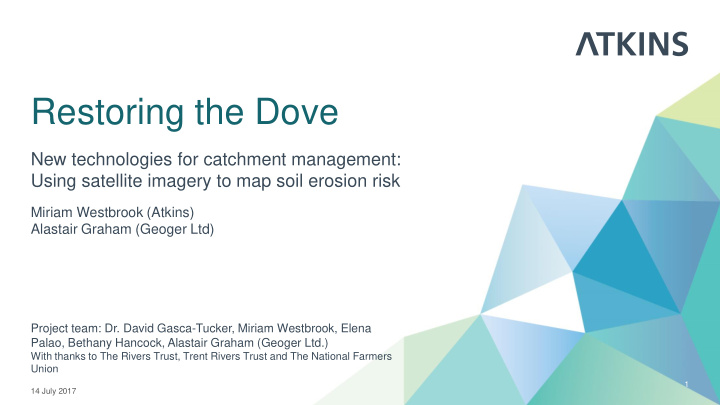



Restoring the Dove New technologies for catchment management: Using satellite imagery to map soil erosion risk Miriam Westbrook (Atkins) Alastair Graham (Geoger Ltd) Project team: Dr. David Gasca-Tucker, Miriam Westbrook, Elena Palao, Bethany Hancock, Alastair Graham (Geoger Ltd.) With thanks to The Rivers Trust, Trent Rivers Trust and The National Farmers Union 1 14 July 2017
Outline 1. Background to the project 2. Using satellite imagery and other catchment data 3. Developing new ways of working 4. Limitations 5. Future applications 2 14 July 2017
Background Limestone river along the border of Derbyshire and Staffordshire. Northeast part of the catchment is a National Park, Site of Special Scientific Interest and Special Conservation Area. 26/27 waterbodies failing to achieve Good overall status according to the Water Framework Directive Sediment runoff issues from accelerated bank erosion. Action has been focused in the northeast of the catchment. Photo credit: newlancswalker.wordpress.com/ 14 July 2017 3
Background North • Steep slopes • Small hill farmers • Mainly sheep farming • Farmer engagement constraints (e.g. mobile/internet signal) South • Flatter slopes • Large agricultural enterprises • Mainly arable crops
Project partners 14 July 2017 5
Challenge: How can Sentinel data help improve targeting of catchment management measures? 14 July 2017 6
Data sources • EU Copernicus Sentinel-2 • SCIMAP • Environment Agency • Corine Land Cover • Forestry Commission • Natural England • DEFRA • Ordnance Survey All free and open source! 14 July 2017 7
Making data visible ESRI StoryMap • Interactive web-based portal to share information. • Allows users to compare layers of data. • Organise data into thematic tabs. • Using text, images and charts alongside mapped data. • Stakeholder engagement tool (dependent on internet access). 14 July 2017 8
Making data visible SCIMAP Connectivity Floodplain Slope 14 July 2017 9
Sentinel-2 data Discovering soil erosion risk at field scale Sentinel-2 bands 2,3,4,8 downloaded and stacked DOS atmospheric correction applied NDVI calculated Simple unsupervised classification (roughly corresponded to cloud, vegetation, bare soil, water, built environment) Digitised bare field locations for final product 14 July 2017 10
Sentinel-2 data Peat Discovering soil erosion risk at field scale Quarries Bare fields 20 th April 2016 14 July 2017 11
Investigating new ways of combining datasets How does the physical nature of the catchment influence soil erosion risk? a) Field slopes b) Soil type c) Proximity to watercourse d) Connectivity to main river receptor Risk mapping assesses erosion risk for every field in the catchment. 14 July 2017 12
Exploring new ways of working with our partners A one day “data hack” with scientists from Atkins and the Environment Agency at Atkins Oxford’s new Digital Design Hub. Working alongside the client to unlock the value in the data and make a difference on the ground. 14 July 2017 13
Developing new workflows Spatial How does the Where does Anthropogenic How does land Response What Temporal physical climate fit into management mitigation nature of the all of this? influence soil actions could catchment erosion risk? we take? • What are the influence soil high risk times • Are any parts • Control at source erosion risk? for soil erosion? (cover crops or no of the 95% of the till approaches to catchment at • Field slopes limit the time soil sediment load in risk (uncovered • Soil type is bare) a river will / bare) during • Intercept • Proximity to typically move in time of high sediment before it 5% of the time, watercourse rainfall? gets into the river in response to • Connectivity to (buffer strips, rainstorm main river wetlands) events. These • Enhance natural receptor are typically river processes to during the ensure the river autumn months . self-cleanses (river restoration) 14 July 2017 14
Limitations & future developments Limitations Spatial resolution Cloud Data volumes Data handling Time constraints Possible future developments (Semi)-automated methods Use of ARD / IntProd Inclusion of Sentinel-1 ARD 14 July 2017 15
Looking forward: What are the potential applications of Sentinel data? 14 July 2017 16
Natural Flood Management visualisation in Evenlode catchment Combining satellite imagery with topography, connectivity and floodplain data. 11/07/17 17
Habitat mapping in extreme environments Goronyo, Nigeria Natural vegetation Goronyo dam Irrigated crops 14 July 2017 18
Conclusions • Sentinel satellite data has the potential to refine the way catchment management is carried out. • The workflow could be applied to other diffuse pollution pressures (e.g. nutrients, pesticides). • Adding a temporal aspect to the suite of catchment data can help us pinpoint the areas of greatest risk at highest risk times. • Working closely with our clients and stakeholders is essential to make sure we unlock the full potential of this data. 11/07/17 19
Thank you miriam.westbrook@atkinsglobal.com a.graham@geoger.co.uk 11/07/17 20
Recommend
More recommend